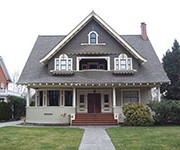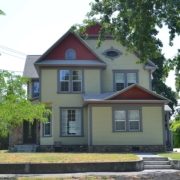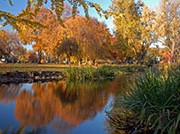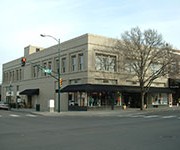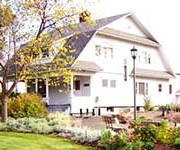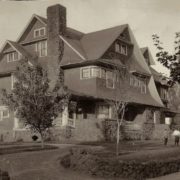History of 1224 East Sumach Street – formerly located at 607 East Main Street – Walla Walla, WA
Property Description:
Block 7 and parts of lots 3, 4 and 5 of Walnut Grove Addition to the City of Walla Walla according to the official plat thereof on file in the office of the Auditor of Walla Walla County, Washington.
Title History:
Walla Walla was originally laid out by surveyor H.H. Chase in 1859, even before its formal incorporation as a city in 1862, as a one quarter-mile square with its eastern side centered on the point where Main Street crossed Mill Creek (at roughly the point where it does now). Main Street originally followed the old Nez Perce Indian Trail. Consequently the streets leading off of it were at right angles to it, and were not in a north-south orientation. This was corrected as the city moved eastward which gave Walla Walla its peculiar street pattern with the three street intersection at Palouse, Boyer and Main Streets. To the original plat, additional parcels were annexed from time to time, usually with the name of the land owner of record at the time the additions were made. During 1862, A. J. Cain surveyed Cain’s Addition to the City (this survey was rerecorded on 5/11/1865, following a disastrous fire which destroyed most of the county’s earlier records). On February 13, 1862 A. J. Cain mortgaged this property to A. H. Reynolds. That debt was repaid in 1866.
On May 12, 1864 Andrew J. and Emma R. Cain, husband and wife, mortgaged a large tract of land to Dorsey S. Baker for the recorded amount of $1. A. J. Cain was an early financier of the Walla Walla Union newspaper; in 1868 he was elected on the Democratic ticket as prosecuting attorney of Walla Walla County. He later moved to Dayton and in September 1874 began publication of the Dayton News, a weekly Democratic newspaper. He became known as the “Father of Columbia County” as a result of his leading role in the formation of that county. Dorsey S. Baker was founder of Walla Walla’s Baker Boyer Bank and builder of the first railroad in the valley. In 1862, Baker was on the city council and some years later was a Walla Walla County Commissioner. He was an early supporter of Whitman Seminary, donating four acres of land for that institution.
Dorsey Baker bought most of Cain’s Addition for $2800 at Sheriff’s Auction. This sale followed a district court action between D. S. Baker, plaintiff, and A. J. Cain and E. R Cain, defendants, over a debt of about $7300 which was secured by the 1864 transaction. Dr. Baker died in Walla Walla June 5, 1888 after which his estate was managed by numerous of his descendants. They filed the plat for Walnut Grove Addition on May 2, 1892 and refiled on December 14, 1898. Baker heirs transferred this property to the Baker Loan and Investment Company.
They sold the lot at 607 E. Main Street to Edward E. and Alice Dean Freeman on June 11, 1901 for $350. The Freemans were listed in the 1902 City Directory as living at 607 E. Main. Mr. Freeman was a clerk at Schwabacher’s Mercantile (later Gardner’s Department Store) at Third and Main. Edward Freeman died in San Francisco on February 29, 1904 and his wife died on May 7, 1904. Mrs. Freeman named Thomas R. Eastman, president and manager of Schwabachers, as executor of the estate and guardian of the three minor Freeman children, Edna
Mae and Edith Mattie, age 13 and Ralph Jewett, age 11. Also named as co-executor and co-guardian was John Brede, an uncle of the children, of Dubuque, Iowa. Although he was bonded on September 22, 1904 he could not serve in full capacity because he was not a resident of Washington state. Mrs. Helen Brede provided a home in Walla Walla for the children following their parents’ deaths until they moved to Iowa some time prior to 1907. The will was entered in probate and declared to be solvent, to be settled without the court’s supervision. The estate inventory included $7500 of personal property and the real property at 607 E. Main, valued at $2200, plus 160 acres of farm land. In May of 1905 Thomas Eastman petitioned the court for permission to purchase an additional 168 acres of adjacent farm land from David H. Cox. This purchase was subsequently contested by John Brede who claimed he had not been consulted or given a description of the land. Brede also accused Eastman of making unsecured loans from the estate. Eastman was discharged as guardian in December of 1908 and the guardianship estate was transferred to Iowa. Throughout this time the residence at 607 E. Main was rented for $25 a month. The guardianship was ended on June 30, 1914 because all the children were of legal age.
On September 4, 1917 Ralph Jewett Freeman et al sold the residence at 607 E. Main to John W. Beissel. Mr. Beissel was a clerk and subsequent manager at the Malcolm McLean Grocery Company who had lived nearby at 10 N. Touchet in 1916-1917. He moved to 607 E. Main after he purchased it until he sold it on March 16, 1920 to Phoebe Frances Ely, the widow of William M. Ely. The first entry for Mrs. Ely in the city directory was in 1925-26 . Living with her at 607 E. Main was a Martha Ely who worked as Dr. E. J. Rhoades’s assistant. By 1926 P. Frances Ely had moved to 314 Juniper.
On March 21, 1927 Phoebe Frances Ely sold this property to Henry and Nina L Eversz for $4000. Mr. Eversz operated the Diamond Laundry and Dry Cleaners at 607 E. Main in 1929-30. His residence was at 1133 East Alder. He changed the name of the business in 1931 to Ideal Cleaners. By 1935 Mr. and Mrs. Eversz had moved their residence to 607 E. Main where they continued to live until Nina Eversz died in 1944. On April 7, 1946 Henry Eversz sold this property to Benjamin and Alma Schiffner for $16,000. Henry Schiffner was listed as “clo clnr” at 607 E. Main in the 1946 City Directory. Alma V. Schiffner was a photographer for Vitart Studio. Benjamin Schiffner was not listed. By 1948 the Royal Cleaners was located at 607 1/2 E. Main, possibly in an outbuilding located on the alley behind the house, and William F. and Willadean Bibb lived at 607 E. Main. In 1949 the house was vacant. On May 31, 1949 Alma (Schiffner) Gray and her husband Claude M. sold the property to the Masonic Temple Association. In January 1950 the Masonic Temple Association sold the house for relocation to Harley R. and Frances C. Pope. In June of that year the Popes engaged Gerald Maher to move it to its present location at 1224 E. Sumach.
Construction of the House:
The house at 607 E. Main was built in 1901 when E. E. Freeman purchased the lot for $350. The City Directory listed him as living there in 1902 and the property was valued at $2200 in 1904. An accounting filed with the courts as a part of the guardianship of the Freeman children indicate that between August and October of 1901 S. F. Henderson, Contractor and Builder of 373 South Second, was paid by for construction work. No building permits were required in 1901.
There has been some confusion among descendants of residents about who lived in 601 and 607 East Main. The house at 601 E. Main on the adjacent lot to the west had a footprint nearly identical to 607 on the 1905 fire map, except that the west wall on 601 had no pop-out like the one on 607. Mrs. Josephine Corliss, a widow, purchased 601 in 1901 and lived there until she sold it in 1920 to James Shea who sold it in 1928 to the last family to live in that location, Rev. Frank A. and Margaret Bown. The disposition of the house at 601 after its purchase by the Masonic Temple Association is unknown.
The house from 607 East Main is now located immediately east of the Little Theater with most of the original details preserved. It is occupied by Henry Pope, son of Harley and Frances Pope.
References:
Bennett, Robert A., Walla Walla Portrait of a Western Town 1804-1899, Pioneer Press, Walla Walla, 1980.
Lyman, Professor W.D., An Illustrated History of Walla Walla County 1901.
Sanborn Fire Maps: 1884-1905 (with updates until 1950).
Walla Walla City Directories: 1880-present (various publishers–not all years).
Mary E. Meeker Walla Walla 2020 Research Service PO Box 1222, Walla Walla WA 99362 February, 2002

